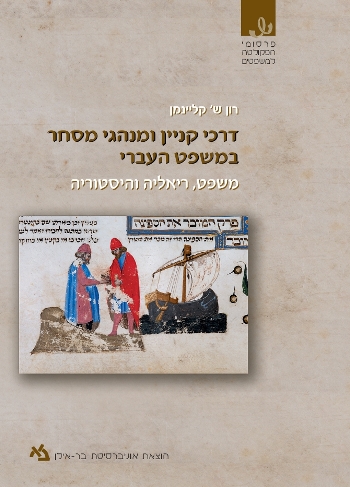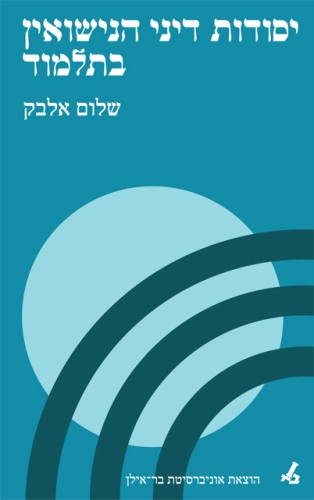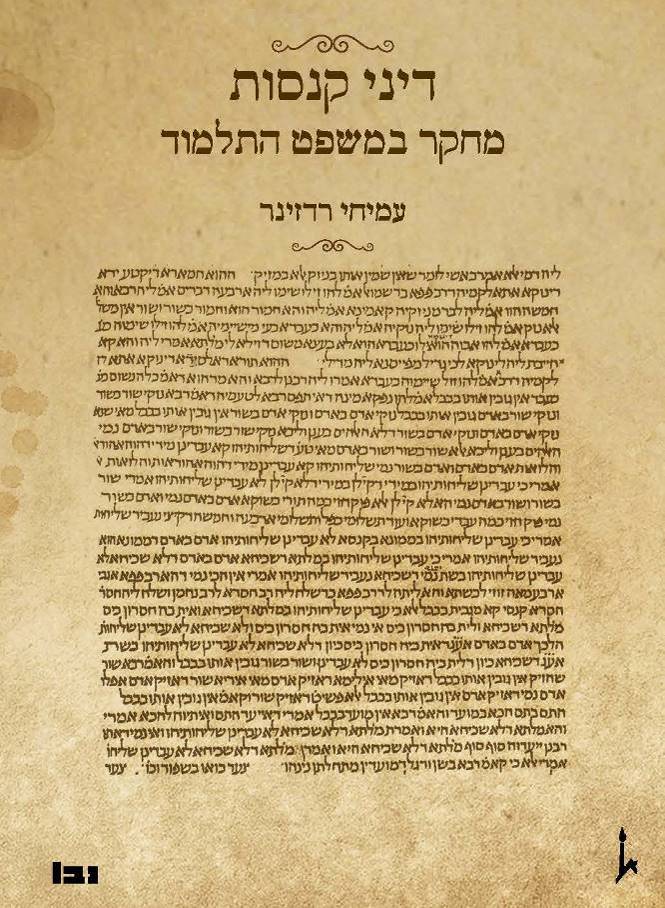Jewish Law Books Supported by the Tager Foundation
Methods of Acquisition and Commercial Customs in Jewish Law - Theory, Practice and History
Ron S. Kleinman
http://www.biupress.co.il/website_en/index.asp?category=127&id=898
Is there halakhic validity to a transaction that is concluded with a handshake, a toast or saying the words “mazal and brakhah”? What is the halakhic status of signing a contract, registering real estate at the Land Registry Office, transactions in future goods, auctions, and online sales transactions? This book addresses these and similar issues. The subject of the book is the validity of commercial customs (practices) involving the transfer of ownership and the creation of an obligation. It examines the fascinating encounter between property law and monetary customs, and more generally, the interaction between Jewish law (halakhah) and custom. The focus is on the gap which exists between Jewish law and the dynamic practices of merchants (minhag hasoharim) as well as the ways in which halakhic decisors deal with this gap.
The book’s interdisciplinary approach to merchant customs combines a scrutiny of the rabbinic literature, of ancient, medieval and modern legal systems, of lexicons and of other historical sources. This approach has yielded contributions in several areas of scholarship.

Subordinated King
Kingship in Classical Jewish Literature
Yair Lorberbaum
http://www.biupress.co.il/website_en/index.asp?category=127&id=650
This book offers a comprehensive study of the authority and status of the king in early rabbinic literature and analyses three conceptions of kingship in biblical literature. The first approach denies kingship, maintaining that God is the King (in Buber`s terms: direct autocracy). The second approach offers a mild version of royal theology, according to which the king is divine (or at least has a unique connection to God). The third approach holds that although the monarchy is necessary, the authority of the king is significantly limited. The author`s study of all the halakhic sources that relate to kingship in Talmudic literature reveals that the early rabbis adopted the third approach, remodeling the status of the king in a new and innovative way. Finally, the author deals with aggadic sources relating to kingship. While the halakhic sources in early rabbinic literature subscribed clearly to the third’ approach, many aggadic sources adopted the two other approaches offered in the Bible.

The Principles of Marriage and Family Law in the Talmud
Shalom Albeck
http://www.biupress.co.il/website_en/index.asp?id=758
This book presents the reasons and purposes behind marriage and family law in the Talmud and the controversies regarding them, thereby providing the reader with an organized, systematic summary of the Talmudic laws on these subjects which have no apparent connection, and granting them new meaning. The discussion sheds light also on social and economic aspects of this period. Among the subjects discussed in this book: matchmaking, betrothal, marriage, forbidden marriages, marriage contracts, mutual duties of husband and wife, duties to children, divorce, Levirate marriage and Halitza, rules of evidence in family law and personal status.

Dine Qenasot: A Research in Talmudic Law
Amihai Radzyner
‘Qenas’ is a term which refers to various monetary obligations. The terms ‘Qenas’ and ‘Dine Qenasot’ [=the laws of ‘Qenasot’] appear in Talmudic literature as well as in the later Halakhic literature. ‘Qenas’ is also a commonly-used term in modern Hebrew, where it means ‘monetary punishment’ or ‘fine’.
The primary aim of this study is to clarify the Talmudic terms ‘Qenas’ and ‘Dine Qenasot’ and by means of this clarification, to gain an insight into the special framework of laws associated with these terms.
The study is called, “‘Dine Qenasot’: A Research in Talmudic Law”, a name which includes three components:
1. “‘Dine Qenasot’”(1): the study deals with the foundations common to all ‘Qenasot’, and not with the characteristics and laws of one specific obligation called ‘Qenas’, except insofar as these are relevant to an understanding of the total framework of ‘Qenasot’.
2. “‘Dine Qenasot’”(2): in Talmudic literature the term ‘Dine Qenasot’ is reserved for obligations whose source our Sages considered to be pentateuchal. Consequently, the study does not deal with obligations known as “Qenasot of our Sages”, which refer to penalties instituted by our Sages, which they termed ‘Qenasot’ too.
3. “Talmudic Law”: this term defines the period covered by the study and the literature with which it is mainly concerned, namely the period in which our Sages (‘Chazal’) lived and the various types of literature stemming from this period. Literature of earlier or later periods has only been referred to where this helps to clarify the legal institutions which took shape during the period with which this study deals.




